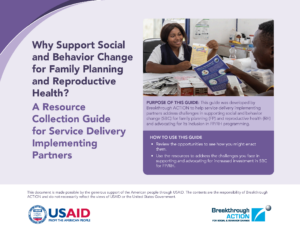Social and behavior change (SBC) is a proven and cost-effective approach[1] for achieving global family planning and reproductive health (FP/RH) goals, such as ensuring universal access to FP/RH information and services. However, certain key decision makers may encounter challenges when supporting or investing in SBC for FP/RH. Previous findings from a behavioral analysis highlighted behavioral barriers and needs related to SBC for FP/RH investment and support.
Based on these findings and an in-depth review of existing resources, Breakthrough ACTION developed three resource collection guides and accompanying FP Insight collections to assist donors, country-level decision makers, and service delivery implementing partners to overcome challenges they face in supporting or investing in SBC for FP/RH. Each guide presents a unique collection of resources tailored to the primary needs and challenges of its intended audience. You can review these guides and the FP Insight collection to explore the different resources available to address not only the challenges but also the opportunities for strengthening SBC for FP/RH investment and support in your particular context.
Ressources et opportunités pour soutenir et investir dans le CSC pour la PF/SR
Le changement social et comportemental (CSC) est une approche éprouvée et rentable permettant d’atteindre les objectifs mondiaux de planification familiale et de santé reproductive (PF/SR), tels que l’accès universel aux informations et services de PF/SR. Cependant, certains décideurs clés peuvent rencontrer des difficultés lorsqu’ils soutiennent ou investissent dans le CSC pour la PF/SR. Les résultats précédents d’une analyse comportementale ont mis en évidence les barrières comportementales et les besoins liés à l’investissement et au soutien du CSC pour la PF/SR.
Sur la base de ces résultats et d’un examen approfondi des ressources existantes, Breakthrough ACTION a élaboré trois guides de collecte de ressources et un recueil d’informations intitulé FP Insight Collection afin d’aider les donateurs, les décideurs au niveau national et les partenaires de mise en œuvre de la prestation de services à surmonter les défis auxquels ils sont confrontés lorsqu’ils soutiennent ou investissent dans le CSC pour la PF/SR. Chaque guide présente une collection unique de ressources adaptées aux principaux besoins et défis du public visé. Vous pouvez consulter ces guides ainsi que le recueil d’informations sur la PF pour explorer les différentes ressources disponibles afin de relever non seulement les défis, mais aussi d’embrasser les opportunités pouvant permettre de consolider les investissements et le soutien au CSC pour la PF/SR dans votre contexte.
[1] Rosen, J.E., Bellows, N., Bollinger, L., Plosky, W.D., & Weinberger, M. (2019). The business case for investing in social and behavior change for family planning. Population Council.
LEARN MORE
EN FRANÇAIS


